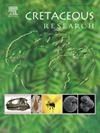Detrital zircon U–Pb geochronology of the trench-fill sandstone on the Cretaceous Shimanto accretionary complex in SW Japan: Implications for provenance and igneous activity in the eastern edge of East Asia
IF 1.9
3区 地球科学
Q1 GEOLOGY
引用次数: 0
Abstract
Cretaceous igneous rocks are widely distributed in the East Asian margin, and their formation is due to the large-scale migration of igneous activity areas from the continental interior to near the subduction margin. Detrital zircon U–Pb ages of trench-fill sandstones of the Shimanto accretionary complex in the Akaishi Mountains of southwest Japan can provide information on eroded igneous rocks, and their location at the eastern edge of East Asia makes them essential for better understanding the intensity and migration of the igneous activity. As a result of the dating, the Cretaceous zircons in the trench-fill sandstones were found to increase dramatically in the middle Cretaceous and to be abundant in the Late Cretaceous. In addition, these large amounts of Cretaceous zircons were found to be derived from igneous rocks such as the Abukuma Granites and Ryoke Granites distributed in the proto-Japan arc. These results indicate that migration of igneous activity from the continental side reached the eastern edge of East Asia in the middle Cretaceous and that large-scale igneous activity continued to occur in the eastern edge of East Asia until the Late Cretaceous. Thus, the detrital zircon age spectra in trench-fill sediments provide a clear picture of the degree of igneous activity in the source area and migration of the igneous activity on active continental margins.
日本西南部白垩纪岛根增生复合体上沟槽填充砂岩的碎屑锆石U-Pb地质年代学:对东亚东部边缘的产状和火成岩活动的影响
白垩纪火成岩广泛分布于东亚边缘,其形成是由于火成岩活动区从大陆内部大规模迁移到俯冲边缘附近。日本西南部赤石山脉岛户增生复合体沟槽充填砂岩的碎屑锆石U-Pb年龄可提供有关侵蚀火成岩的信息,而其位于东亚东部边缘的位置使其对更好地了解火成岩活动的强度和迁移至关重要。测年结果显示,沟槽充填砂岩中的白垩纪锆石在白垩纪中期急剧增加,在晚白垩世则非常丰富。此外,还发现这些大量的白垩纪锆石来自火成岩,如分布在原日本弧的阿武隈花岗岩和良玉花岗岩。这些结果表明,在白垩纪中期,火成岩活动从大陆一侧迁移到东亚东部边缘,直到白垩纪晚期,大规模的火成岩活动仍在东亚东部边缘持续发生。因此,海沟充填沉积物中的碎屑锆石年龄谱可以清楚地显示源区火成岩活动的程度以及火成岩活动在活动大陆边缘的迁移情况。
本文章由计算机程序翻译,如有差异,请以英文原文为准。
求助全文
约1分钟内获得全文
求助全文
来源期刊

Cretaceous Research
地学-地质学
CiteScore
4.10
自引率
19.00%
发文量
235
审稿时长
12 weeks
期刊介绍:
Cretaceous Research provides a forum for the rapid publication of research on all aspects of the Cretaceous Period, including its boundaries with the Jurassic and Palaeogene. Authoritative papers reporting detailed investigations of Cretaceous stratigraphy and palaeontology, studies of regional geology, and reviews of recently published books are complemented by short communications of significant new findings.
Papers submitted to Cretaceous Research should place the research in a broad context, with emphasis placed towards our better understanding of the Cretaceous, that are therefore of interest to the diverse, international readership of the journal. Full length papers that focus solely on a local theme or area will not be accepted for publication; authors of short communications are encouraged to discuss how their findings are of relevance to the Cretaceous on a broad scale.
Research Areas include:
• Regional geology
• Stratigraphy and palaeontology
• Palaeobiology
• Palaeobiogeography
• Palaeoceanography
• Palaeoclimatology
• Evolutionary Palaeoecology
• Geochronology
• Global events.
 求助内容:
求助内容: 应助结果提醒方式:
应助结果提醒方式:


